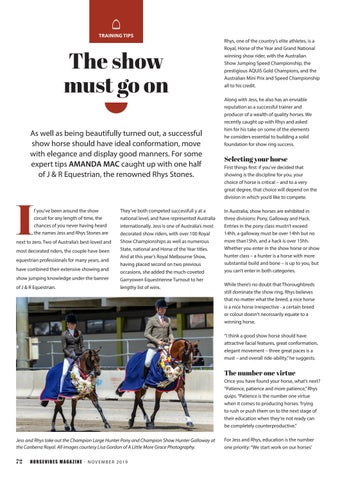TRAINING TIPS
The show must go on As well as being beautifully turned out, a successful show horse should have ideal conformation, move with elegance and display good manners. For some expert tips AMANDA MAC caught up with one half of J & R Equestrian, the renowned Rhys Stones.
I
f you’ve been around the show circuit for any length of time, the chances of you never having heard the names Jess and Rhys Stones are
next to zero. Two of Australia’s best-loved and most decorated riders, the couple have been equestrian professionals for many years, and have combined their extensive showing and show jumping knowledge under the banner of J & R Equestrian.
They’ve both competed successfull y at a national level, and have represented Australia internationally. Jess is one of Australia’s most decorated show riders, with over 100 Royal Show Championships as well as numerous State, national and Horse of the Year titles. And at this year’s Royal Melbourne Show, having placed second on two previous occasions, she added the much-coveted Garryowen Equestrienne Turnout to her lengthy list of wins.
Rhys, one of the country’s elite athletes, is a Royal, Horse of the Year and Grand National winning show rider, with the Australian Show Jumping Speed Championship, the prestigious AQUIS Gold Champions, and the Australian Mini Prix and Speed Championship all to his credit. Along with Jess, he also has an enviable reputation as a successful trainer and producer of a wealth of quality horses. We recently caught up with Rhys and asked him for his take on some of the elements he considers essential to building a solid foundation for show ring success.
Selecting your horse First things first: if you’ve decided that showing is the discipline for you, your choice of horse is critical – and to a very great degree, that choice will depend on the division in which you’d like to compete. In Australia, show horses are exhibited in three divisions: Pony, Galloway and Hack. Entries in the pony class mustn’t exceed 14hh, a galloway must be over 14hh but no more than15hh, and a hack is over 15hh. Whether you enter in the show horse or show hunter class – a hunter is a horse with more substantial build and bone – is up to you, but you can’t enter in both categories. While there’s no doubt that Thoroughbreds still dominate the show ring, Rhys believes that no matter what the breed, a nice horse is a nice horse irrespective - a certain breed or colour doesn’t necessarily equate to a winning horse. “I think a good show horse should have attractive facial features, great conformation, elegant movement – three great paces is a must – and overall ride-ability,” he suggests.
The number one virtue Once you have found your horse, what’s next? “Patience, patience and more patience,” Rhys quips. “Patience is the number one virtue when it comes to producing horses. Trying to rush or push them on to the next stage of their education when they’re not ready can be completely counterproductive.” Jess and Rhys take out the Champion Large Hunter Pony and Champion Show Hunter Galloway at the Canberra Royal. All images courtesy Lisa Gordon of A Little More Grace Photography. 72
HORSEVIBES MAGAZINE - NOVEMBER 2019
For Jess and Rhys, education is the number one priority: “We start work on our horses’




















